 According to Encyclopedia Britannica, “Algae are defined as a group of predominantly aquatic, photosynthetic, and nucleus-bearing organisms that lack the true roots, stems, leaves, and specialized multicellular reproductive structures of plants.”1 Sounds simple, but in actuality, algae is straight-up essential to life on this planet, primarily because 1) algae supply most of the planet’s oxygen, and 2) algae are the food base for nearly all aquatic life on earth.1 But the utility of algae goes way beyond that. Algae are used throughout world and across multiple industries, including food, cosmetics, and pharmaceuticals, as preservatives, stabilizing agents, and more. Algae are used to make biodiesel fuel and control pollution, and are even used to make ice cream, tooth paste, and lotions.2 Algae are also healthy and sustainable sources of food for humans. But there are thousands (if not millions) of species of algae in the world.3 Which species are suitable for human consumption? What is their nutritional value? In what form are they consumed? Are there any risks associated with consuming algae-based foods? Here, we review the basics of algae as a sustainable food source for humans.
According to Encyclopedia Britannica, “Algae are defined as a group of predominantly aquatic, photosynthetic, and nucleus-bearing organisms that lack the true roots, stems, leaves, and specialized multicellular reproductive structures of plants.”1 Sounds simple, but in actuality, algae is straight-up essential to life on this planet, primarily because 1) algae supply most of the planet’s oxygen, and 2) algae are the food base for nearly all aquatic life on earth.1 But the utility of algae goes way beyond that. Algae are used throughout world and across multiple industries, including food, cosmetics, and pharmaceuticals, as preservatives, stabilizing agents, and more. Algae are used to make biodiesel fuel and control pollution, and are even used to make ice cream, tooth paste, and lotions.2 Algae are also healthy and sustainable sources of food for humans. But there are thousands (if not millions) of species of algae in the world.3 Which species are suitable for human consumption? What is their nutritional value? In what form are they consumed? Are there any risks associated with consuming algae-based foods? Here, we review the basics of algae as a sustainable food source for humans.
Algae Species for Human Consumption
There are four main types of edible algae: blue-green (e.g., chlorella, spirulina); brown (e.g., kelp, kombu); green, (e.g., sea grapes, sea lettuce); and red (e.g., nori, sea (Irish) moss).4
Nutritional Value and Forms of Consumption
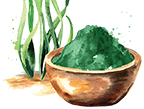 Spirulina. Spirulina is a nutrient dense food—It is low in calories, but high in vitamins, minerals, and protein. One tablespoon (20 calories) contains four grams of protein, one gram of fat, and two grams of carbohydrates. Additionally, spirulina is considered a good source of vitamins B1, B2, B3, copper, iron, and magnesium. It also contains a plant pigment called phycocyanin, which has been shown to have antioxidant, pain-relief, anti-inflammatory, and brain-protective properties.5 Amino acids make up 62 percent of spirulina.
Spirulina. Spirulina is a nutrient dense food—It is low in calories, but high in vitamins, minerals, and protein. One tablespoon (20 calories) contains four grams of protein, one gram of fat, and two grams of carbohydrates. Additionally, spirulina is considered a good source of vitamins B1, B2, B3, copper, iron, and magnesium. It also contains a plant pigment called phycocyanin, which has been shown to have antioxidant, pain-relief, anti-inflammatory, and brain-protective properties.5 Amino acids make up 62 percent of spirulina.
Spirulina is available in pill or powder form or as flakes.6 Spirulina can be mixed into water, juice, or smoothies and consumed as a beverage. It can also be sprinkled on food such as yogurt. It is a common ingredient in protein and energy-boosting powder mixes or bars.
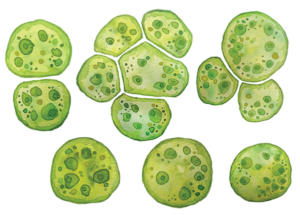 Chlorella. Chlorella is also a nutrient dense food—it is low in calories, but high in vitamins, minerals, and protein. Just under one teaspoon (3.9g) contains 10 calories, two grams of protein, and one gram of carbohydrates. Chlorella is a good source of vitamin A, zinc, iron, phosphorus, magnesium, and vitamins B1, B2, and B9. Depending on its source, chlorella contains about 50 to 60-percent complete protein with all nine essential amino acids.7
Chlorella. Chlorella is also a nutrient dense food—it is low in calories, but high in vitamins, minerals, and protein. Just under one teaspoon (3.9g) contains 10 calories, two grams of protein, and one gram of carbohydrates. Chlorella is a good source of vitamin A, zinc, iron, phosphorus, magnesium, and vitamins B1, B2, and B9. Depending on its source, chlorella contains about 50 to 60-percent complete protein with all nine essential amino acids.7
Like spirulina, chlorella is available in pill or powder form, and is also available in liquid form. Chlorella can be mixed into water, juice, or a smoothie and consumed as a beverage. It can also be sprinkled on food, such as yogurt.
 Kelp. Kelp is sometimes marketed under the name kombu. Like other forms of algae, kelp has a solid nutritional profile. It is high in iodine and iron and is a good source of calcium, folate, magnesium, and vitamin K. A one-ounce serving of dried kelp has 68 calories, five grams of protein, one gram of fat, and 11 grams of carbohydrates.8
Kelp. Kelp is sometimes marketed under the name kombu. Like other forms of algae, kelp has a solid nutritional profile. It is high in iodine and iron and is a good source of calcium, folate, magnesium, and vitamin K. A one-ounce serving of dried kelp has 68 calories, five grams of protein, one gram of fat, and 11 grams of carbohydrates.8
Kelp can be consumed fresh, frozen, dried (whether dried whole, dried and ground into powder, or dried into flakes) or in the form of kelp noodles. It is a popular flavoring for soups and salads. Fresh kelp is often prepared as a salad.
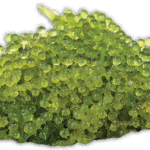 Sea grapes. Sea grapes, also known as umibudo seaweed, are not to be confused with the seagrape tree in the Caribbean. Sea grapes are a type of green algae that resembles clusters of fish eggs. Sea grapes are a good source of protein, phosphorus, calcium, magnesium, iodine, and copper. They also contain vitamins A, C, E, and some B vitamins. Sea grapes have antioxidant properties.9
Sea grapes. Sea grapes, also known as umibudo seaweed, are not to be confused with the seagrape tree in the Caribbean. Sea grapes are a type of green algae that resembles clusters of fish eggs. Sea grapes are a good source of protein, phosphorus, calcium, magnesium, iodine, and copper. They also contain vitamins A, C, E, and some B vitamins. Sea grapes have antioxidant properties.9
Sea grapes can be consumed fresh or can be purchased in dehydrated form that can be reconstituted in water. Sea grapes are commonly served in salads and stir-fries.
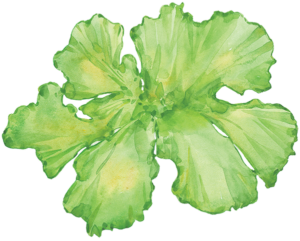 Sea lettuce. Sea lettuce is considered a good source of vitamin B12, protein, iron, fiber, and calcium. It is also high in sodium, potassium, magnesium, iodine, aluminium, manganese, and nickel and contains vitamins A, B1, and C, and numerous trace elements. Like other algae, sea lettuce has also been shown to have antioxidant properties, as well as analgesic and anti-inflammatory characteristics.10
Sea lettuce. Sea lettuce is considered a good source of vitamin B12, protein, iron, fiber, and calcium. It is also high in sodium, potassium, magnesium, iodine, aluminium, manganese, and nickel and contains vitamins A, B1, and C, and numerous trace elements. Like other algae, sea lettuce has also been shown to have antioxidant properties, as well as analgesic and anti-inflammatory characteristics.10
Fresh sea lettuce is commonly used in salads. It is also served cooked in soups.
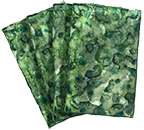 Nori. Nori is probably one of the most popular types of algae consumed by humans worldwide. Per 100 grams, nori has 35 calories with five grams of carbohydrates and five grams of protein. Nori is a particularly good source of vitamin A, followed by vitamin C, manganese, and riboflavin. It is also a good source of several other vitamins and minerals, such as folates, copper, and iron.11
Nori. Nori is probably one of the most popular types of algae consumed by humans worldwide. Per 100 grams, nori has 35 calories with five grams of carbohydrates and five grams of protein. Nori is a particularly good source of vitamin A, followed by vitamin C, manganese, and riboflavin. It is also a good source of several other vitamins and minerals, such as folates, copper, and iron.11
Nori is typically harvested then dried in thin sheets. Nori is incorporated into food in many ways, but is probably most commonly used to wrap sushi rolls or cut into strips and served in miso soup.
 Sea moss. Sea moss is sometimes referred to as Irish sea moss, depending on where it was harvested. Four tablespoons of sea moss has 10 calories and provides 0.5 grams of protein, 3 grams of carbohydrates, and 0.5 grams of fiber. Sea moss is a good source of iron, magnesium, phosphorus, zinc, and copper. Like other algae, sea moss is also a good source of iodine and has demonstrated antioxidant properties.12
Sea moss. Sea moss is sometimes referred to as Irish sea moss, depending on where it was harvested. Four tablespoons of sea moss has 10 calories and provides 0.5 grams of protein, 3 grams of carbohydrates, and 0.5 grams of fiber. Sea moss is a good source of iron, magnesium, phosphorus, zinc, and copper. Like other algae, sea moss is also a good source of iodine and has demonstrated antioxidant properties.12
Sea moss is most commonly available in supplement form.
Sustainability
Algae has a higher protein yield per unit area than terrestrial crops, such as soybean, legumes, and wheat. Unlike terrestrial agriculture and meat farming, algae does not require fresh water or arable land to grow.3 Researchers report that algae grows 10 times faster than terrestrial crops and requires less than a tenth of the land needed by terrestrial crops to yield equivalent biomass.13 The negative impact that large-scale agriculture has on the environment (e.g., decreased biodiversity, fertilizer run-off into fresh water sources, disease-susceptible crops, local food insecurity as a result of monoculture etc) is significantly reduced, if not eliminated, when growing algae.13
Potential Health Risks
While research in algae as globally sustainable food and biofuel sources continues to grow and expand our knowledge base, it is still an understudied area of science, particularly the impact that excessive intake of algae-based foods may have on health.14 Because algae naturally grow in bodies of water, any toxins in the water, such as heavy metals and arsenic, can accumulate in the algae, particularly if grown near industrialized areas where risk of contaminated water run-off is more likely.14 More research is needed to determine the impact this may have on human health. Additionally, most algae consumed by humans contain substantial amounts of iodine. While iodine is an essential nutrient to the human body, excessive intake can result in thyroid dysfunction.14 Individuals with thyroid issues should avoid consuming algae-based foods unless under the direct supervision of a physician. And finally, some algae—notably spirulina— have anticoagulant properties. Individuals taking blood thinning medications should avoid consuming spirulina or other algae with anticoagulant properties, unless under direct supervision of a physician.
All in all, clearer guidelines and regulations on producing and labeling algae-based foods are needed.
Bottom Line
Algae is a sustainable, eco-friendly crop with many uses across multiple industries, including a nutrient-dense food source for humans. Due to their potentially high iodine content and/or anticoagulant properties, algae-based foods may not be suitable for those with thyroid conditions or those taking blood thinners. Additionally, toxins from polluted waters can accumulate in algae, which, if consumed, may pose health risks to humans. Consult with your physician or nutritionist to see if algae consumption is right for you.
Sources
1. Encyclopedia Britannica website. Algae. https://www.britannica.com/summary/algae. Accessed 30 Nov 2021.
2. BiologyWise site. Uses of algae. https://biologywise.com/uses-of-algae. Accessed 30 Nov 2021.
3. Guiry MD. How many species of algae are there? J Phycol. 2012;48(5):1057–1063.
4. Shirvell B. An introduction to algae: the latest superfood. 20 Mar 2020. Martha Stewart website. https://www.marthastewart.com/7735546/algae-superfood-explained. Accessed 1 Dec 2021.
5. WebMD website. Spirulina: are there health benefits? https://www.webmd.com/diet/spirulina-health-benefits#1-2. Accessed 1 Dec 2021.
6. Mount Sinai website. Spirulina. https://www.mountsinai.org/health-library/supplement/spirulina. Accessed 1 Dec 2021.
7. WebMD website. Chlorella: are there health benefits? https://www.webmd.com/diet/chlorella-health-benefits#1. Accessed 1 Dec 2021.
8. WebMD website. Health benefits of kelp. https://www.webmd.com/diet/health-benefits-kelp#2. Accessed 1 Dec 2021.
9. Hedge R. Umibudo (sea grapes): taste, benefits, and how to use. 20 Sep 2020. Organic Facts website. https://www.organicfacts.net/umibudo-sea-grapes.html. 1 Dec 2021.
10. Rasyid A. Evaluation of nutritional composition of the dried seaweed Ulva lactuca from Pameungpeuk waters, Indonesia. Trop Life Sci Res. 2017;28(2):119–125.
11. Nutrition and You website. Nori seaweed nutrition facts. https://www.nutrition-and-you.com/nori-seaweed.html. Accessed 1 Dec 2021.
12. Panoff L. Sea moss: benefits, nutrition, and how to prepare it. 12 Feb 2021. Healthline website. https://www.healthline.com/nutrition/seamoss. Accessed 1 Dec 2021.
13. Bleakley S, Hayes M. Algal proteins: extraction, application, and challenges concerning production. Foods. 2017;6(5):33.
14. Cherry P, O’Hara C, Magee PJ, et al. Risks and benefits of consuming edible seaweeds. Nutr Rev. 2019;77(5):307–329.





